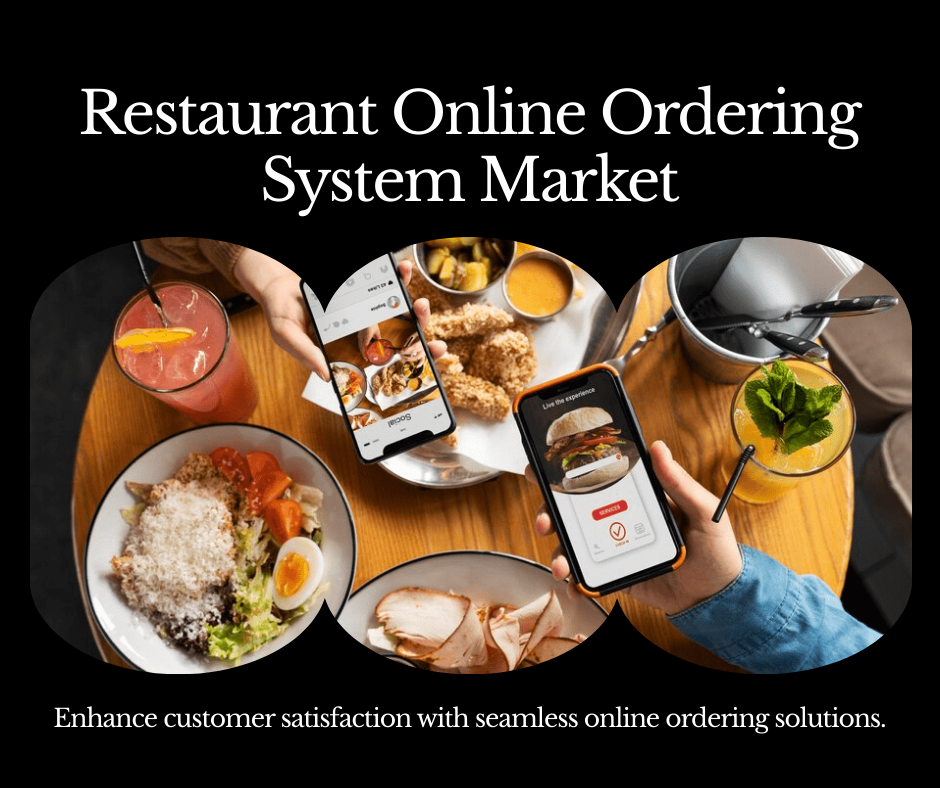
Market Overview
The global Restaurant Online Ordering System Market was valued at USD 26,795 million in 2024 and is projected to reach USD 49,595.67 million by 2032, growing at a CAGR of 8% over the forecast period. This remarkable growth highlights the transformation in how restaurants and customers interact, order, and transact in a rapidly digitizing world. As digital convenience becomes a core expectation, the market is evolving into a vital component of the modern food service landscape.
Online ordering systems have become a critical pillar of restaurant operations globally, offering scalability, operational efficiency, and superior customer engagement. These platforms streamline the food ordering process via web or mobile applications, enabling users to place orders seamlessly without waiting in queues or navigating phone calls. In an age where customer experience drives brand loyalty, the value of intuitive, fast, and reliable ordering systems cannot be overstated.
The COVID-19 pandemic further accelerated the adoption of digital solutions, positioning online ordering as not just a convenience but a necessity. Whether it’s for dine-in, takeaway, or delivery services, digital platforms empower restaurants to stay relevant in a competitive ecosystem. As technological advancements continue to reshape consumer expectations and restaurant workflows, the online ordering market is poised for steady innovation and sustained growth.
Read full report: https://www.credenceresearch.com/report/restaurant-online-ordering-system-market
Market Drivers
Surge in On-Demand Consumption Habits
Urbanization and the hustle of modern life have led consumers to seek convenience in every aspect of their daily routines. Online food ordering provides a time-saving solution that aligns perfectly with on-the-go lifestyles. This behavioral shift is evident across demographics, particularly in metropolitan areas where dining habits are driven by convenience and speed. The rising number of working professionals and dual-income households also fuels this demand. As a result, restaurants are increasingly investing in robust digital platforms to retain and attract customers. This change has created a consistent upward trend in platform usage and revenue.
Advancements in Digital Payment Infrastructure
With the rise of contactless payments, mobile wallets, and secure gateways, customers now enjoy frictionless payment experiences. This technological evolution encourages more people to adopt digital ordering platforms. Seamless integration of payment options within ordering apps enhances trust, reduces abandonment rates, and encourages higher spending. Fintech collaborations with restaurants also add value by providing financial analytics, promotions, and loyalty schemes. As cash transactions decline and digital payments become the norm, ordering platforms benefit from this infrastructural evolution. Strong backend payment systems are also essential for handling large order volumes securely and efficiently.
Growing Investments in Restaurant Tech
Venture capital and private equity firms are increasingly recognizing the potential of restaurant technology. From POS integrations to AI-powered chatbots and cloud-based platforms, investment in tech infrastructure is gaining momentum. These innovations help restaurants cut costs, increase efficiency, and deliver better customer experiences. The availability of SaaS-based models allows even small restaurants to implement sophisticated systems affordably. Investor confidence in this sector leads to rapid product development and competitive offerings. Technology companies continue to innovate features that cater to specific cuisines, demographics, and geographies, driving market diversity.
Global Expansion of Food Aggregators
Large aggregators like Uber Eats, Just Eat, and Deliveroo have extended their footprint across continents, bridging the gap between restaurants and digital-first consumers. Their aggressive market entry strategies and promotional campaigns educate and convert consumers at scale. Restaurants, in turn, benefit from expanded visibility and streamlined logistics. The success of these aggregators reinforces the need for individual restaurants to also offer online ordering services independently. Their continued expansion helps normalize digital ordering across cultures and regions. These players act as both partners and competitors, compelling traditional restaurants to evolve their own ordering solutions.
Market Challenges
Expensive Initial Setup and Maintenance
Building or subscribing to a professional-grade ordering system can be a significant financial strain, particularly for independent or small-scale restaurants. Initial expenses include technology infrastructure, app or website development, and third-party integrations. Over time, maintaining the system—ensuring security patches, customer support, and feature updates—adds recurring costs. These expenditures can eat into already thin margins, especially for restaurants operating in competitive markets. As costs accumulate, businesses must carefully evaluate return on investment. This challenge makes affordability a central concern, often deterring early-stage adoption despite clear benefits.
Fragmented Technology Ecosystems
Restaurants may already use legacy POS, inventory, or CRM systems that are not compatible with modern ordering software. Integrating these disparate tools often leads to inefficiencies and data misalignment. Poor integration can result in delayed orders, inaccurate billing, and customer dissatisfaction. Moreover, managing multiple vendors or service providers complicates IT operations. Inconsistent updates and miscommunication across platforms disrupt workflows and reduce service quality. This lack of seamless integration remains a major bottleneck to system adoption and operational agility.
Overdependence on Aggregators
While food delivery platforms offer instant reach, their high commission rates reduce profitability. Restaurants may become overly reliant on third-party channels, sacrificing brand identity and customer data access. Aggregators often control the user interface, promotions, and customer interactions, making it harder for restaurants to build long-term relationships. In addition, sudden changes in aggregator policies can impact pricing or availability. Over-reliance limits the restaurant’s strategic independence and margin control. This dynamic pushes many operators to invest in proprietary systems despite the associated costs.
Cybersecurity and Data Concerns
Online ordering platforms deal with sensitive user data, including personal information and payment credentials. Any breach can lead to reputational damage, legal liabilities, and lost business. As data privacy regulations tighten globally, non-compliance becomes a serious risk. Hackers targeting restaurant databases have exposed vulnerabilities in poorly secured systems. Restaurants must therefore implement encryption, secure APIs, and authentication protocols to safeguard information. Investing in cybersecurity is not optional—it is essential for trust-building and regulatory adherence. However, this adds complexity and cost to the digital transformation journey.
Market Opportunity
Expansion of App-Based Services
The explosion in smartphone ownership has created new touchpoints for consumer engagement. Mobile apps that support intuitive navigation, menu browsing, and real-time tracking are reshaping the digital dining experience. Restaurants that invest in feature-rich apps can gain a loyal customer base. App-exclusive discounts and loyalty programs further incentivize downloads and repeat usage. Voice and gesture controls are also being explored as next-gen interface options. The mobile-first approach will continue to define future market strategies.
Rise of Subscription-Based Dining Models
Subscription plans offering weekly or monthly meal packages are gaining traction, particularly among busy professionals and health-conscious customers. Online ordering platforms enable seamless subscription management, personalized menus, and timely reminders. This model generates consistent revenue for restaurants while providing convenience to users. Such strategies are being adopted by QSRs, health food providers, and cloud kitchens alike. As recurring revenue models become more common, online platforms will play a central role in execution.
Tech Adoption in Emerging Markets
As digital infrastructure improves in emerging economies, there is immense potential for online ordering systems to capture untapped demand. Affordable smartphones and growing internet penetration fuel this trend. Government support for digital transformation and cashless economies also aids market growth. Local entrepreneurs and food tech start-ups are capitalizing on regional tastes and preferences. Tailoring platforms to cultural nuances enhances adoption. These regions could soon become the primary growth engines for the global market.
Strategic Partnerships and Integrations
Technology providers are increasingly forming partnerships with POS vendors, logistics providers, and marketing agencies to offer all-in-one platforms. Such collaborations enhance the value proposition for restaurants, simplifying implementation and reducing operational burdens. Open API ecosystems encourage customization and innovation. Strategic alliances with telecom operators, banks, or ride-hailing companies further extend reach. As ecosystems become interconnected, market entrants can scale faster and serve customers more efficiently.
Market Segmentation
By Delivery Type
- In-house Delivery
- Third-party Delivery
By Platform
- Mobile Applications
- Websites
- Kiosks
By Service Type
- Dine-in
- Takeaway
- Delivery
By Payment Method
- Credit/Debit Cards
- Digital Wallets
- Cash on Delivery
- Prepaid Cards
By End-User
- Independent Restaurants
- Chain Restaurants
- Quick Service Restaurants (QSRs)
- Fast Casual Restaurants
- Full-Service Restaurants
Based on Region
- North America (U.S., Canada, Mexico)
- Europe (UK, France, Germany, etc.)
- Asia Pacific (China, Japan, India, etc.)
- Latin America (Brazil, Mexico, Argentina, etc.)
- Middle East & Africa (GCC, South Africa, etc.)
Regional Analysis
North America
North America remains the frontrunner in adopting restaurant ordering technologies. The U.S. leads in digital innovation and food delivery platform usage, especially among Millennials and Gen Z. Restaurants have embraced omnichannel strategies, integrating dine-in and delivery experiences. Canada also sees strong growth, driven by urban expansion and mobile connectivity. Mexico is rapidly developing its food tech ecosystem, supported by youth-driven digital behavior. Partnerships with fintech and loyalty programs enhance user retention. High consumer expectations continue to drive platform refinement and user interface improvements.
Europe
Europe shows mature market behavior, with diverse culinary traditions aligning with digital preferences. Countries like the UK and Germany lead in food tech investments and adoption. Western Europe is characterized by tech-enabled sustainability initiatives in food delivery. Multi-lingual support and regulatory compliance are essential for cross-border operations. Southern European nations are catching up, with localized solutions catering to cultural dining norms. The rise of eco-friendly packaging and electric delivery vehicles is shaping future trends. Consumer loyalty is shaped by seamless service and brand ethics.
Asia Pacific
Asia Pacific is the most dynamic market with explosive growth potential. China dominates in volume, supported by giants like Meituan and Ele.me. India, Indonesia, and the Philippines are seeing a boom in digital payments and app-based food ordering. Governments support digital inclusion, making this a fertile ground for expansion. Start-ups and conglomerates alike are targeting middle-income urban households. Mobile-first strategies and regional cuisine platforms are highly successful. Hyper-localization and aggressive marketing define the competitive landscape.
Latin America
Latin America is emerging as a vibrant market, driven by smartphone penetration and a youthful population. Brazil leads with innovative start-ups and consumer-centric platforms. Mexico is benefiting from cross-border digital adoption and infrastructure upgrades. Despite economic disparities, user base expansion continues across major cities. Local delivery networks and cloud kitchens are gaining popularity. Culturally tailored offerings help improve app retention rates. Regulatory support is slowly improving digital ecosystem stability.
Middle East & Africa
The Middle East, particularly the UAE and Saudi Arabia, is witnessing fast-paced growth in online food services. High per capita income and mobile connectivity make this region attractive. Government initiatives encourage digital entrepreneurship. Africa, especially South Africa, is developing gradually with infrastructural challenges. Mobile money solutions are helping overcome payment barriers. Localization of menus and voice support enhance usability. As regional economies stabilize, the food tech sector is expected to grow steadily.
Top Companies
- Menufy
- Restolabs
- Olo
- Upserve
- Square
- iMenu360
- MenuDrive
- Toast POS
- ChowNow
- Orders2me
Future Outlook
- Mobile-first ordering platforms will dominate, with continued investment in UI/UX design.
Brands will prioritize native apps with personalized user experiences to improve retention. - AI and machine learning will enhance personalized recommendations and upselling.
Restaurants will use real-time data for dynamic pricing and smart menu suggestions. - Voice-activated ordering will gain traction through smart devices and home assistants.
Hands-free convenience will appeal to tech-savvy customers and busy households. - Integration of loyalty programs will drive customer retention and repeat orders.
Gamified rewards and tailored discounts will boost user engagement over time. - Automation in kitchens and delivery will synchronize with online systems for speed.
Robots and AI systems will streamline operations, reducing human errors. - Cloud kitchens and virtual brands will rely on ordering systems for operations.
Digital-only models will expand into niche markets and lifestyle segments. - Blockchain may improve transaction transparency and data security in the future.
Smart contracts and encrypted logs will build consumer trust in digital orders. - Third-party aggregator partnerships will evolve with flexible revenue models.
Hybrid collaborations will offer more control and reduced commissions to restaurants. - Sustainability in packaging and last-mile delivery will become a major focus.
Eco-conscious practices will influence consumer decisions and platform branding. - Expansion into tier-2 and tier-3 cities will unlock new revenue streams.
Localized strategies and regional content will drive market penetration.
Read full report: https://www.credenceresearch.com/report/restaurant-online-ordering-system-market










